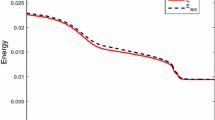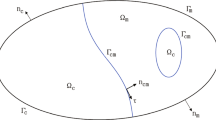Abstract
We propose a novel second order in time, fully decoupled and unconditionally stable numerical scheme for solving the Cahn–Hilliard–Darcy system which models two-phase flow in porous medium or in a Hele–Shaw cell. The scheme is based on the ideas of second order convex-splitting for the Cahn–Hilliard equation and pressure-correction for the Darcy equation. The computation of order parameter, pressure and velocity is completely decoupled in our scheme. We show that the scheme is uniquely solvable, unconditionally energy stable and mass-conservative. Ample numerical results are presented to gauge the efficiency and robustness of our scheme.







Similar content being viewed by others
References
Lee, H.-G., Lowengrub, J.S., Goodman, J.: Modeling pinchoff and reconnection in a Hele-Shaw cell. I. The models and their calibration. Phys. Fluids 14(2), 492–513 (2002). https://doi.org/10.1063/1.1425843
Lee, H.-G., Lowengrub, J.S., Goodman, J.: Modeling pinchoff and reconnection in a Hele–Shaw cell. II. Analysis and simulation in the nonlinear regime. Phys. Fluids 14(2), 514–545 (2002). https://doi.org/10.1063/1.1425844
Wise, S.M.: Unconditionally stable finite difference, nonlinear multigrid simulation of the Cahn–Hilliard–Hele–Shaw system of equations. J. Sci. Comput. 44(1), 38–68 (2010). https://doi.org/10.1007/s10915-010-9363-4
Bear, J.: Dynamics of Fluids in Porous Media. Courier Dover Publications, Mineola (1988)
Nield, D.A., Bejan, A.: Convection in Porous Media, 2nd edn, p. 546. Springer, New York (1999)
Han, D., Wang, X.: Decoupled energy-law preserving numerical schemes for the Cahn–Hilliard–Darcy system. Numer. Methods Partial Differ. Equ. 32(3), 936–954 (2016). https://doi.org/10.1002/num.22036
Dedè, L., Garcke, H., Lam, K.F.: A Hele–Shaw–Cahn–Hilliard model for incompressible two-phase flows with different densities. J. Math. Fluid Mech. (2017). https://doi.org/10.1007/s00021-017-0334-5
Feng, X., Wise, S.: Analysis of a Darcy–Cahn–Hilliard diffuse interface model for the Hele–Shaw flow and its fully discrete finite element approximation. SIAM J. Numer. Anal. 50(3), 1320–1343 (2012). https://doi.org/10.1137/110827119
Wang, X., Zhang, Z.: Well-posedness of the Hele–Shaw–Cahn–Hilliard system. Ann. Inst. H. Poincaré Anal. Non Linéaire 30(3), 367–384 (2013). https://doi.org/10.1016/j.anihpc.2012.06.003
Wang, X., Wu, H.: Long-time behavior for the Hele–Shaw–Cahn–Hilliard system. Asymptot. Anal. 78(4), 217–245 (2012)
Lowengrub, J., Titi, E., Zhao, K.: Analysis of a mixture model of tumor growth. Eur. J. Appl. Math. 24(5), 691–734 (2013). https://doi.org/10.1017/S0956792513000144
Jiang, J., Wu, H., Zheng, S.: Well-posedness and long-time behavior of a non-autonomous Cahn–Hilliard–Darcy system with mass source modeling tumor growth. J. Differ. Equ. 259(7), 3032–3077 (2015). https://doi.org/10.1016/j.jde.2015.04.009
Han, D.: A decoupled unconditionally stable numerical scheme for the Cahn–Hilliard–Hele–Shaw system. J. Sci. Comput. 1–20 (2015). https://doi.org/10.1007/s10915-015-0055-y
Han, D., Wang, X.: Initial-boundary layer associated with the nonlinear Darcy–Brinkman system. J. Differ. Equ. 256(2), 609–639 (2014). https://doi.org/10.1016/j.jde.2013.09.014
Chemetov, N., Neves, W.: The generalized Buckley–Leverett system: solvability. Arch. Ration. Mech. Anal. 208(1), 1–24 (2013). https://doi.org/10.1007/s00205-012-0591-7
Anderson, D.M., McFadden, G.B., Wheeler, A.A.: Diffuse-interface methods in fluid mechanics. In: Annual Review of Fluid Mechanics, Vol. 30. Annu. Rev. Fluid Mech., vol. 30, pp. 139–165. Annual Reviews, Palo Alto, CA (1998)
Lowengrub, J., Truskinovsky, L.: Quasi-incompressible Cahn–Hilliard fluids and topological transitions. R. Soc. Lond. Proc. Ser. A Math. Phys. Eng. Sci. 454(1978), 2617–2654 (1998). https://doi.org/10.1098/rspa.1998.0273
Magaletti, F., Picano, F., Chinappi, M., Marino, L., Casciola, C.M.: The sharp-interface limit of the Cahn–Hilliard–Navier–Stokes model for binary fluids. J. Fluid Mech. 714, 95–126 (2013). https://doi.org/10.1017/jfm.2012.461
Guo, R., Xia, Y., Xu, Y.: An efficient fully-discrete local discontinuous Galerkin method for the Cahn–Hilliard–Hele–Shaw system. J. Comput. Phys. 264, 23–40 (2014). https://doi.org/10.1016/j.jcp.2014.01.037
Diegel, A.E., Feng, X.H., Wise, S.M.: Analysis of a mixed finite element method for a Cahn–Hilliard–Darcy–Stokes system. SIAM J. Numer. Anal. 53(1), 127–152 (2015). https://doi.org/10.1137/130950628
Chen, W., Liu, Y., Wang, C., Wise, S.M.: Convergence analysis of a fully discrete finite difference scheme for the Cahn–Hilliard–Hele–Shaw equation. Math. Comp. 85(301), 2231–2257 (2016). https://doi.org/10.1090/mcom3052
Liu, Y., Chen, W., Wang, C., Wise, S.M.: Error analysis of a mixed finite element method for a Cahn–Hilliard–Hele–Shaw system. Numer. Math. 135(3), 679–709 (2017). https://doi.org/10.1007/s00211-016-0813-2
Eyre, D.J.: Unconditionally gradient stable time marching the Cahn-Hilliard equation. In:Computational and Mathematical Models of Microstructural Evolution (San Francisco, CA, 1998). Mater. Res. Soc. Sympos. Proc., vol. 529, pp. 39–46. MRS, Warrendale, PA (1998)
Collins, C., Shen, J., Wise, S.M.: An efficient, energy stable scheme for the Cahn–Hilliard–Brinkman system. Commun. Comput. Phys. 13(4), 929–957 (2013)
Feng, X.: Fully discrete finite element approximations of the Navier–Stokes–Cahn–Hilliard diffuse interface model for two-phase fluid flows. SIAM J. Numer. Anal. 44(3), 1049–1072 (2006). https://doi.org/10.1137/050638333
Kay, D., Styles, V., Welford, R.: Finite element approximation of a Cahn–Hilliard–Navier–Stokes system. Interf. Free Bound. 10(1), 15–43 (2008). https://doi.org/10.4171/IFB/178
Shen, J., Yang, X.: A phase-field model and its numerical approximation for two-phase incompressible flows with different densities and viscosities. SIAM J. Sci. Comput. 32(3), 1159–1179 (2010). https://doi.org/10.1137/09075860X
Shen, J.: Modeling and numerical approximation of two-phase incompressible flows by a phase-field approach. In:Multiscale Modeling and Analysis for Materials Simulation. Lect. Notes Ser. Inst. Math. Sci. Natl. Univ. Singap., vol. 22, pp. 147–195. World Sci. Publ., Hackensack, NJ, (2012)
Grün, G.: On convergent schemes for diffuse interface models for two-phase flow of incompressible fluids with general mass densities. SIAM J. Numer. Anal. 51(6), 3036–3061 (2013). https://doi.org/10.1137/130908208
Guo, Z., Lin, P., Lowengrub, J.S.: A numerical method for the quasi-incompressible Cahn–Hilliard–Navier–Stokes equations for variable density flows with a discrete energy law. J. Comput. Phys. 276, 486–507 (2014). https://doi.org/10.1016/j.jcp.2014.07.038
Minjeaud, S.: An unconditionally stable uncoupled scheme for a triphasic Cahn–Hilliard/Navier–Stokes model. Numer. Methods Partial Differ. Equ. 29(2), 584–618 (2013). https://doi.org/10.1002/num.21721
Shen, J., Yang, X.: Decoupled, energy stable schemes for phase-field models of two-phase incompressible flows. SIAM J. Numer. Anal. 53(1), 279–296 (2015). https://doi.org/10.1137/140971154
Shen, J., Yang, X., Yu, H.: Efficient energy stable numerical schemes for a phase field moving contact line model. J. Comput. Phys. 284, 617–630 (2015). https://doi.org/10.1016/j.jcp.2014.12.046
Guermond, J.-L., Salgado, A.: A splitting method for incompressible flows with variable density based on a pressure Poisson equation. J. Comput. Phys. 228(8), 2834–2846 (2009). https://doi.org/10.1016/j.jcp.2008.12.036
Hu, Z., Wise, S.M., Wang, C., Lowengrub, J.S.: Stable and efficient finite-difference nonlinear-multigrid schemes for the phase field crystal equation. J. Comput. Phys. 228(15), 5323–5339 (2009). https://doi.org/10.1016/j.jcp.2009.04.020
Baskaran, A., Lowengrub, J.S., Wang, C., Wise, S.M.: Convergence analysis of a second order convex splitting scheme for the modified phase field crystal equation. SIAM J. Numer. Anal. 51(5), 2851–2873 (2013). https://doi.org/10.1137/120880677
Shen, J., Wang, C., Wang, X., Wise, S.M.: Second-order convex splitting schemes for gradient flows with Ehrlich–Schwoebel type energy: application to thin film epitaxy. SIAM J. Numer. Anal. 50(1), 105–125 (2012). https://doi.org/10.1137/110822839
Han, D., Wang, X.: A second order in time, uniquely solvable, unconditionally stable numerical scheme for Cahn–Hilliard–Navier–Stokes equation. J. Comput. Phys. 290, 139–156 (2015). https://doi.org/10.1016/j.jcp.2015.02.046
van Kan, J.: A second-order accurate pressure-correction scheme for viscous incompressible flow. SIAM J. Sci. Statist. Comput. 7(3), 870–891 (1986). https://doi.org/10.1137/0907059
Kim, J., Kang, K., Lowengrub, J.: Conservative multigrid methods for Cahn–Hilliard fluids. J. Comput. Phys. 193(2), 511–543 (2004). https://doi.org/10.1016/j.jcp.2003.07.035
Diegel, A.E., Wang, C., Wang, X., Wise, S.M.: Convergence analysis and error estimates for a second order accurate finite element method for the Cahn–Hilliard–Navier–Stokes system. Numerische Mathematik, 1–40 (2017). https://doi.org/10.1007/s00211-017-0887-5
Dong, S., Shen, J.: A time-stepping scheme involving constant coefficient matrices for phase-field simulations of two-phase incompressible flows with large density ratios. J. Comput. Phys. 231(17), 5788–5804 (2012). https://doi.org/10.1016/j.jcp.2012.04.041
Aland, S.: Time integration for diffuse interface models for two-phase flow. J. Comput. Phys. 262, 58–71 (2014). https://doi.org/10.1016/j.jcp.2013.12.055
Guillén-González, F., Tierra, G.: On linear schemes for a Cahn–Hilliard diffuse interface model. J. Comput. Phys. 234, 140–171 (2013). https://doi.org/10.1016/j.jcp.2012.09.020
Yang, X., Zhao, J., Wang, Q., Shen, J.: Numerical approximations for a three-components cahnhilliard phase-field model based on the invariant energy quadratization method. Math. Models Methods Appl. Sci. 1–38 (2017). https://doi.org/10.1142/S0218202517500373. http://www.worldscientific.com/doi/pdf/10.1142/S0218202517500373
Cheng, Q., Yang, X., Shen, J.: Efficient and accurate numerical schemes for a hydro-dynamically coupled phase field diblock copolymer model. J. Comput. Phys. 341, 44–60 (2017). https://doi.org/10.1016/j.jcp.2017.04.010
Yang, X., Ju, L.: Linear and unconditionally energy stable schemes for the binary fluid-surfactant phase field model. Comput. Methods Appl. Mech. Eng. 318, 1005–1029 (2017). https://doi.org/10.1016/j.cma.2017.02.011
Zhao, J., Yang, X., Gong, Y., Wang, Q.: A novel linear second order unconditionally energy stable scheme for a hydrodynamic Q-tensor model of liquid crystals. Comput. Methods Appl. Mech. Eng. 318, 803–825 (2017). https://doi.org/10.1016/j.cma.2017.01.031
Yang, X., Zhao, J., Wang, Q.: Numerical approximations for the molecular beam epitaxial growth model based on the invariant energy quadratization method. J. Comput. Phys. 333, 104–127 (2017). https://doi.org/10.1016/j.jcp.2016.12.025
Yang, X., Han, D.: Linearly first- and second-order, unconditionally energy stable schemes for the phase field crystal equation. J. Comput. Phys. 330, 1116–1134 (2017)
Guermond, J.L., Minev, P., Shen, J.: An overview of projection methods for incompressible flows. Comput. Methods Appl. Mech. Engrg. 195(44–47), 6011–6045 (2006). https://doi.org/10.1016/j.cma.2005.10.010
Guermond, J.-L., Quartapelle, L.: On the approximation of the unsteady Navier-Stokes equations by finite element projection methods. Numer. Math. 80(2), 207–238 (1998). https://doi.org/10.1007/s002110050366
Han, D., Wang, X., Wu, H.: Existence and uniqueness of global weak solutions to a Cahn–Hilliard–Stokes–Darcy system for two phase incompressible flows in karstic geometry. J. Differ. Equ. 257(10), 3887–3933 (2014). https://doi.org/10.1016/j.jde.2014.07.013
Diegel, A.E., Wang, C., Wise, S.M.: Stability and convergence of a second-order mixed finite element method for the Cahn–Hilliard equation. IMA J. Numer. Anal. 36(4), 1867–1897 (2016). https://doi.org/10.1093/imanum/drv065
Hecht, F.: New development in freefem++. J. Numer. Math. 20(3–4), 251–265 (2012)
Christlieb, A., Jones, J., Promislow, K., Wetton, B., Willoughby, M.: High accuracy solutions to energy gradient flows from material science models. J. Comput. Phys. 257(part A), 193–215 (2014). https://doi.org/10.1016/j.jcp.2013.09.049
Glasner, K., Orizaga, S.: Improving the accuracy of convexity splitting methods for gradient flow equations. J. Comput. Phys. 315, 52–64 (2016). https://doi.org/10.1016/j.jcp.2016.03.042
Le Bars, M., Worster, M.G.: Interfacial conditions between a pure fluid and a porous medium: implications for binary alloy solidification. J. Fluid Mech. 550, 149–173 (2006). https://doi.org/10.1017/S0022112005007998
Saffman, P.G., Taylor, G.: The penetration of a fluid into a porous medium or Hele–Shaw cell containing a more viscous liquid. Proc. Roy. Soc. Lond. Ser. A 245, 312–3292 (1958)
Acknowledgements
The work of X. Wang is supported in part by DMS 1715504 and grants from Fudan University. The work of D. Han is supported by a seed fund from the Material Research Center at Missouri University of Science and Technology. The authors wish to thank Wenbin Chen, Mike Jolly and Jie Shen for helpful discussions.
Author information
Authors and Affiliations
Corresponding author
Rights and permissions
About this article
Cite this article
Han, D., Wang, X. A Second Order in Time, Decoupled, Unconditionally Stable Numerical Scheme for the Cahn–Hilliard–Darcy System. J Sci Comput 77, 1210–1233 (2018). https://doi.org/10.1007/s10915-018-0748-0
Received:
Revised:
Accepted:
Published:
Issue Date:
DOI: https://doi.org/10.1007/s10915-018-0748-0




